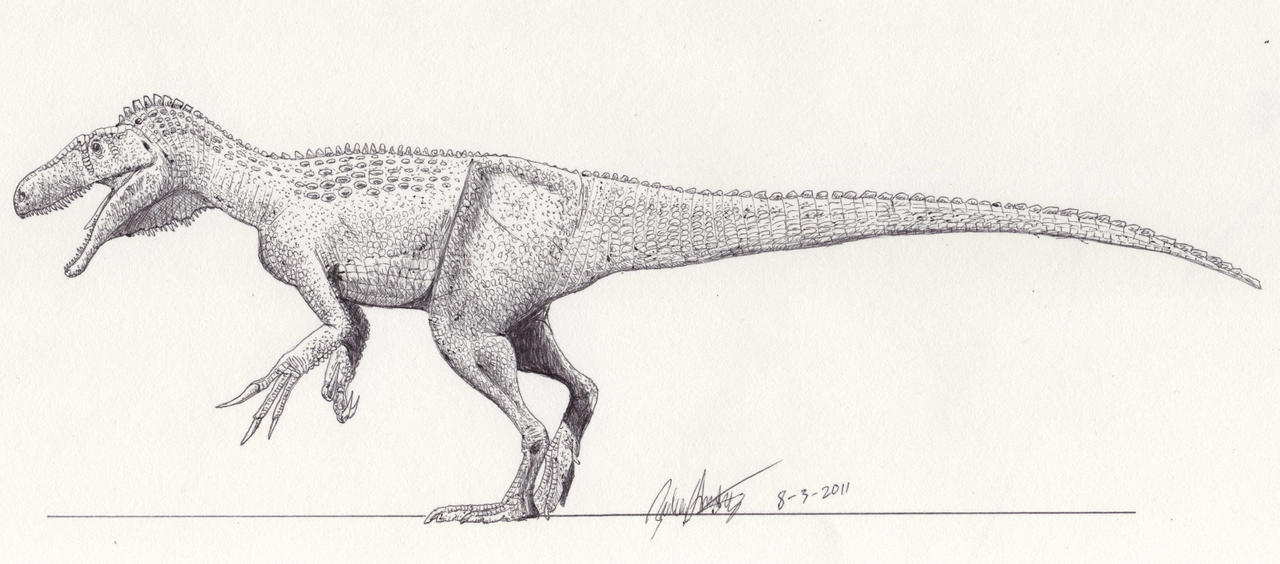|
|
Post by Infinity Blade on Dec 22, 2014 4:37:55 GMT 5
Marshosaurus bicentesimusMarshosaurus is a genus of medium-sized carnivorous theropod dinosaur, belonging to the Megalosauroidea, from the Late Jurassic Morrison Formation of Utah and perhaps Colorado. Marshosaurus was medium-sized theropod. In 2010 Gregory S. Paul estimated its length at 4.5 metres, its weight at two hundred kilogrammes. The holotype ilium has a length of 375 millimetres. If the cranial material is correctly referred, the skull was about sixty centimetres long. In 2012, Matthew Carrano established one autapomorphy, a unique derived trait of the holotype: the suture between the pubic peduncle and the pubic bone is convex, curving upwards, at the front and concave at the rear.  © @ paleozoologist (Zach A.)Kelenken guillermoiKelenken guillermoi is an giant flightless predatory bird of the family Phorusrhacidae or "terror birds". K. guillermoi lived in the Langhian stage of the Miocene, some 15 million years ago, in Argentina along with Argentavis. With a skull 28 inches (71 cm) long (including its 18 inch, 45.7 cm beak), it had the largest head of any known bird. It is the largest species of phorusrhacid. The tarsometatarsus was about 45 cm long. It is not entirely clear how Kelenken captured and killed its prey. As a large flightless carnivore, Kelenken likely chased down and killed its prey with several bone-shattering blows from its massive beak. Another possibility is that it may have picked up its prey item, then proceeded to shake it vigorously in order break its back. It is also possible that Kelenken may have been a scavenger, driving off other predators from their kills with its impressive size.  © @ Roman Uchytel
|
|
gigadino96
Junior Member
  Vi ravviso, o luoghi ameni
Vi ravviso, o luoghi ameni
Posts: 226 
|
Post by gigadino96 on Dec 22, 2014 17:13:41 GMT 5
Does anybody know Kelen's weight? The only estimate I could find was 150-250 kg, but this estimate comes from an unreliable source.
|
|
|
|
Post by Infinity Blade on Dec 25, 2014 0:12:45 GMT 5
I think theropod once said ~300kg back on Carnivora and IIRC, he said on here that ~250kg might be conservative. I think both combatants here should be in the same weight range.
|
|
|
|
Post by Ceratodromeus on Dec 26, 2014 4:55:20 GMT 5
~400kg for marshosaurus seemed like a bit much to me. I liie Paul's ~250kg estimate, so using this, i'd say 60/40 in favor of the kelenken
|
|
gigadino96
Junior Member
  Vi ravviso, o luoghi ameni
Vi ravviso, o luoghi ameni
Posts: 226 
|
Post by gigadino96 on Dec 27, 2014 3:25:09 GMT 5
If Kelenken is really 300 kg, it's got the edge due to its size advantage.
|
|
|
|
Post by Infinity Blade on Dec 27, 2014 3:38:40 GMT 5
I think ~300kg (while I do think is plausible) should be taken with some amount of caution. On the other hand, Marshosaurus was also stated by blaze to have probably gotten larger. theworldofanimals.proboards.com/post/16261 |
|
blaze
Paleo-artist   
Posts: 766
|
Post by blaze on Dec 27, 2014 19:04:04 GMT 5
The only way I could find to estimate the mass of Kelenken is through Field et al. (2013) "Skeletal Correlates for Body Mass Estimation in Modern and Fossil Flying Birds" equation for mass from minimum tarsometatarsal shaft width.
In Kelenken that measurement probably is 48.82mm (Bertelli et al.,2007 table 1) which suggests a mass of 237kg. Of course, this being an equation for flying birds and this measurement not being the best at estimating body mass (95% prediction interval goes as low as 91kg to as high as 612kg, ridiculous) means this estimate should still be taken with a grain of salt
|
|
Deleted
Deleted Member
Posts: 0
|
Post by Deleted on Apr 4, 2018 1:20:40 GMT 5
Marsho wins. Kelenken cannot fight against a creature of similar height.
|
|
|
|
Post by dinosauria101 on Feb 10, 2019 1:29:41 GMT 5
Yeah, Kelenken is gonna have trouble fighting its foe here.
I favor the theropod.
|
|